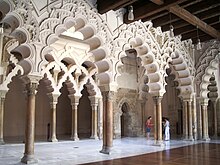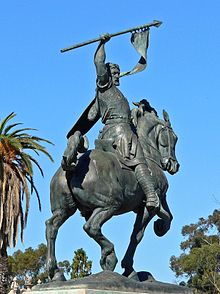Yusuf al-Mutaman
Yusuf ibn Ahmad , Arabic يوسف بن أحمد, DMG yūsuf ibn aḥmad , was the third emir of the Hudids in the Taifa of Saragossa between 1081 and 1085 (or 474 to 478 according to the Islamic calendar ) .
biography
Yusuf ibn Ahmad, with full name Arabic أبو عامر يوسف بن أحمد بن هود المؤتمن, DMG abū 'āmir yūsuf ibn aḥmad ibn hūd al-mū'taman , was one of the two sons of Ahmad I. al-Muqtadir . He was probably born in the fortress palace Aljafería in Saragossa , but his exact date of birth is unknown. When he succeeded his father to the throne in 1081 after his death, the Taifa of Saragossa was at its brilliant climax of Muslim culture. Ahmad I. al-Muqtadir had divided the Taifa kingdom between his two sons as follows: Yusuf ibn Ahmad received the western half with Saragossa, Tudela , Huesca and Calatayud , whereas his brother al-Mundir received the eastern half on the Mediterranean coast with Lérida , Monzón , Tortosa and Dénia was allocated.
Yusuf al-Mutaman was an educated and wise ruler who protected science, philosophy and the arts. He himself mastered astrology, philosophy and especially mathematics - in the latter area he even published his own book. He continued his father's endeavors and gathered intellectuals around him who lingered in the beautiful Aljafería , the "Palace of Joy".
Military conflicts with Aragon
The first challenge for Yusuf ibn Ahmad was to withstand the threat from the King of Aragon Sancho I , who wanted to expand his territory southwards at the expense of the Zaragoza Taifa.
In this dispute, Yusuf ibn Ahmad knew the mercenary troops of Rodrigo Diaz de Vivar , better known as El Cid , on his side. This Castillian nobleman was owned by his King Alfonso VI. banished because he had carried out raids against the interests of the king on his own in the Taifa of Toledo , although the latter paid tribute to the Castillian king and for this reason should not have been attacked. El Cid therefore offered his services to Ahmad I al-Muqtadir in 1081 and remained loyal to his son Yusuf ibn Ahmad during his relatively short reign. He was only to quit his service in 1086, when Alfonso VI's Saragossa. was besieged.
The Cid was able to hold up the troops of Aragon until 1083, when Sancho I took the line of fortifications laid out to protect the cities in the Saragossa typhoon that same year. These include fortresses like the Graus in the east (which posed a threat to Barbastro ), Ayerbe , Bolea and Arascués (as a deterrent for Huesca ) and the Tudela in Arguedas . Sancho I also threatened several cities near La Sotonera and in the Violada plain such as Almudévar , Barbués , Sangarrén , Tabernas and Vicién and made them tribute.
Disputes with neighboring taifas
The Cid also had the task of appropriating the eastern territories ruled by the brother al-Mundir, since he had allied himself with Aragón. There were constant acts of war on the border between the two kingdoms, but neither of the two brothers succeeded in reuniting the paternal ancestral lands. El Cid then undertook a campaign against the Lérida defended by al-Mundir, but the Count of Barcelona Berengar Raymond II and the King of Aragon Sancho I were on al-Mundir's side. In the meantime, the cid strengthened the fortresses of Monzón and Tamarite . In the Battle of Almenar , his army then succeeded in routing the coalition troops of al-Mundir and Berengar Raymond II and taking Berengar Raymond II's brother prisoner.
At this point, Yusuf al-Muzaffar, the uncle of Yusuf al-Mutaman, plotted along with a certain Albofalac (or Abu-l-Jalaq). Yusuf al-Muzaffar had previously been the Taifa of Lérida, but was then overthrown from the throne by his brother, Ahmad I al-Muqtadir, and imprisoned in the fortress of Rueda de Jalón . The conspirators also received support from King Alfonso VI of Castile, who set out in September 1082 with a strong army in the direction of Rueda. Alfons VI was accompanied. by Ramiro from Pamplona, a son of Sancho III. , and the Castilian Gonzalo Salvadórez. Yusuf al-Muzaffar died towards the end of the year, so that the castellan Albofalac suddenly changed sides. He even went so far as to ambush the Castillians and kill both Ramiro and Gonzalo.
In 1084 the Cid was tasked with attacking Morella . Against the intruder, al-Mundir, who had Lérida, Tortosa and Dénia under control, again received help from Sancho I of Aragon. On August 14, 1084, the two armies met at Morella (or Olocau del Rey ). El Cid won the Battle of Morella brilliantly and captured several Aragonese nobles, including the Bishop of Roda , Raimund Dalmacio, and the Count of Navarre Sancho Sánchez de Erro.
Yusuf al-Mutaman also tried to forge better relationships with his vassal Abu Bakar, the Taifa of Valencia through his marriage policy. The Valencia Taifa was entangled in a complex alliance system. Alfonso VI had then proposed Al-Qādir , the Taifa of Toledo, to drive Abu Bakar out of Valencia with his help, but expected the city of Toledo as pledge . In fact, Alfonso VI. Capture Toledo in 1085. This was a severe blow for Yusuf al-Mutaman, as the Taifa of Saragossa was now cut off from the traditional land route to the rest of al-Andalus and could only be reached via Valencia and the Levant.
mathematician

The main mathematical work of Yusuf al-Mutaman was his book of perfection and optical appearances , Arabic كتاب الستكمال والمناظر, DMG kitāb al-istikmal wa al-munāẓir . This compilation contained Greek mathematics from, among others, Euclid and Archimedes , theorems of Thābit ibn Qurra , the Banu Musa brothers and Alhazen as well as own theorems. It is thanks to Maimonides that his book reached Egypt , from where it was passed on to Baghdad in the 14th century . Its distribution was limited to the world of the Orient and had almost no influence on the Christian West.
There are only two copies of his book left today. A copy was found in 1985 in Istanbul in the Askerî Müze library . It came from the library of the Ottoman Sultan Mehmed II , which was then passed on to his son Bayezid II . A second copy was later discovered in Cairo .
The book deals with irrational numbers , conic sections , the quadrature of parabolic curve segments , volumes and areas of various geometric objects and - among other mathematical problems - the course of the circular tangent .
In his book, Yusuf al-Mutaman attempts an Aristotelian classification of mathematics. The classification includes a chapter on arithmetic , two chapters on geometry and two other chapters on stereometry . He is the first mathematician who the sentence of Giovanni Ceva had formulated long before this.
The sentence described in Ceva's De lineis rectis of 1678 reads as follows:
“A triangle with the endpoints ABC is divided by the points D, E, and F on its sides BC, CA and AB. The straight lines AD, BE and CF are drawn to these lateral points. The three straight lines only meet at one point if the following condition is met:. "
This is equivalent to saying:
Offspring
A son of Yusuf al-Mutaman is known who succeeded him to the throne after his death:
- Ahmad II ruled with the honorary title of al-Musta'in from 1085 until his death in 1110 as the Taifa of Saragossa.
literature
- Ana I. Carrasco Manchado, Juan Martos Quesada and Juan A. Souto Lasala: Al-Andalus . Istmo (Historia de España. Historia medieval, VI), Madrid 2009, ISBN 978-84-7090-431-8 , p. 249 .
- José Cervera Fras: El reino de Saraqusta . CAI, Saragossa 1999, ISBN 84-88305-93-1 .
- JL Corral Lafuente: Zaragoza musulmana (714-1118) . In: coll. “Historia de Zaragoza” (no 5) . 1998, ISBN 84-8069-155-7 .
- A. Djebbar: La rédaction de l'Istikmâl d'al-Mu'taman (XIe s.) Par Ibn Sartâq un mathématicien des XIIIe-XIVe siècles . In: Historia Mathematica . vol. 24, 1997, pp. 185-192 .
- Jan P. Hogendijk: Discovery of an 11th-century geometrical compilation: The Istikmal of Yusuf al-Mu'taman ibn Hud, King of Saragossa . In: Historia Mathematica . vol. 13, 1986, pp. 43-52 .
- Jan P. Hogendijk: Al-Mu'taman ibn Hud, 11th-century king of Saragossa and brilliant mathematician . In: Historia Mathematica . tape 22 , 1995, p. 1-18 .
- Alberto Montaner Frutos: Introducción histórica to chapter El palacio musulmán . In: Bernabé Cabañero Subiza et al. (Ed.): La Aljafería . vol. I. Cortes de Aragón, Saragossa 1998, ISBN 84-86794-97-8 , p. 35-65 .
- Maria Jesús Viguera Molins: Aragón musulmán . Mira editores, Saragossa 1988, ISBN 84-86778-06-9 .
- Maria Jesús Viguera Molins: El islam en Aragón . CAI, (Mariano de Pano in Ruata, 9), Saragossa 1995.
- DJ Wasserstein: The rise and fall of the party kings. Politics and society in Islamic Spain, 1002-1086 . Princeton 1985.
Individual evidence
- ↑ Mestre i Campi, Jesús: Diccionari d'Història de Catalunya, entry: "Yúsuf ibn Ahmad al-Mu'tamin" . Edicions 62, 1998, ISBN 84-297-3521-6 , pp. 1143 .
- ↑ Sobrequés i Vidal, Santiago: Història de Catalunya . vol. 2. Cupsa Editorial, 1979, ISBN 84-390-0125-8 , pp. 15 .
| predecessor | Office | successor |
|---|---|---|
| Ahmad I. al-Muqtadir |
Emir of Saragossa 1081-1085 |
Ahmad II |
| personal data | |
|---|---|
| SURNAME | Yusuf al-Mutaman |
| ALTERNATIVE NAMES | Abu-Amir Yusuf ibn Ahmad ibn Hud al-Mutaman |
| BRIEF DESCRIPTION | Saragossa Taifa |
| DATE OF BIRTH | 11th century |
| DATE OF DEATH | 1085 |



